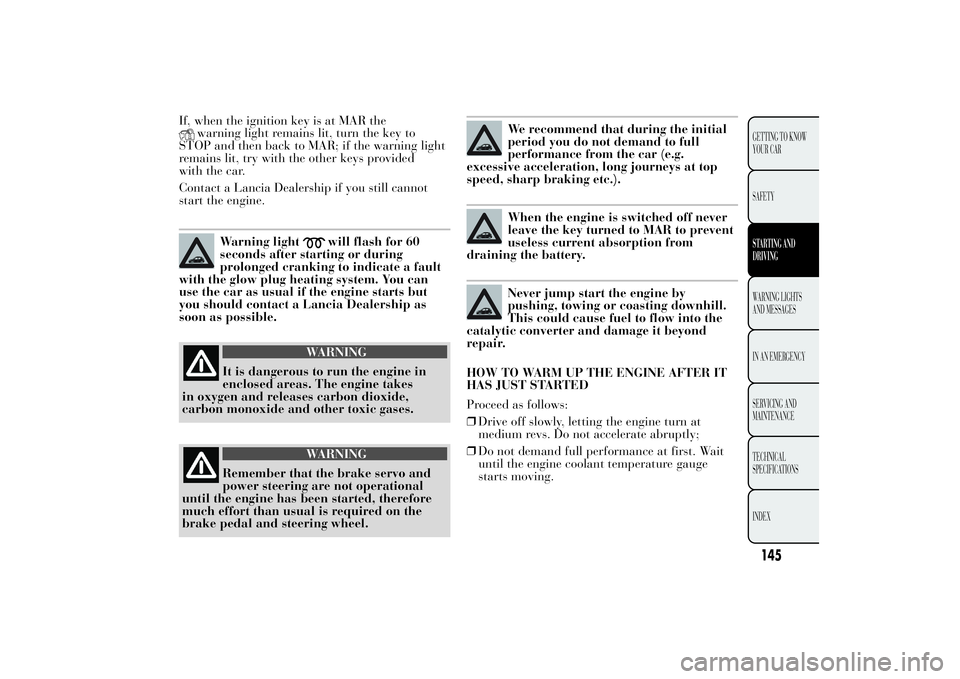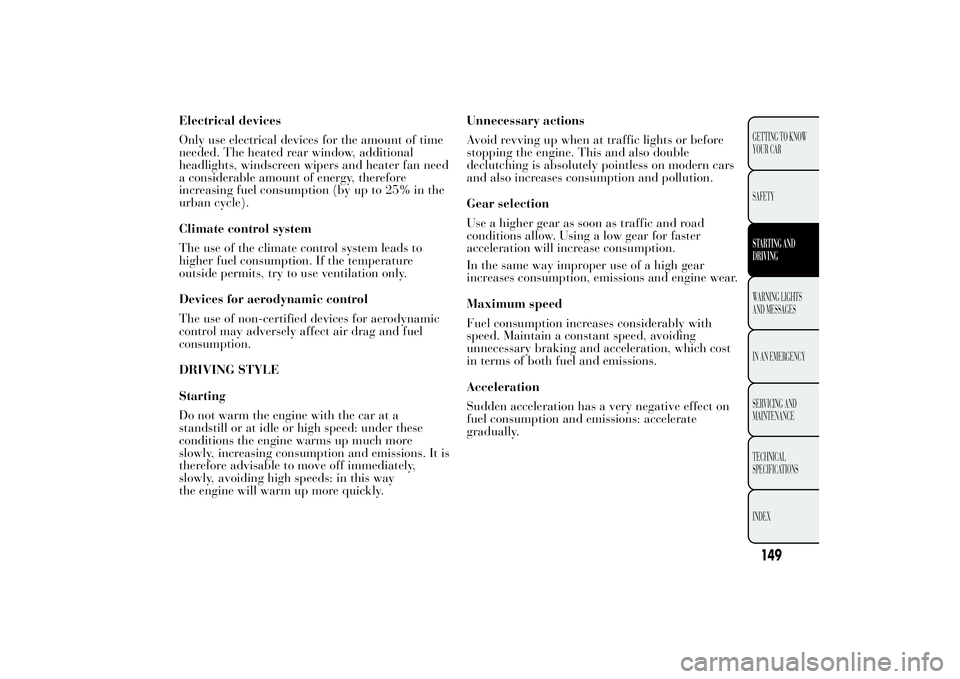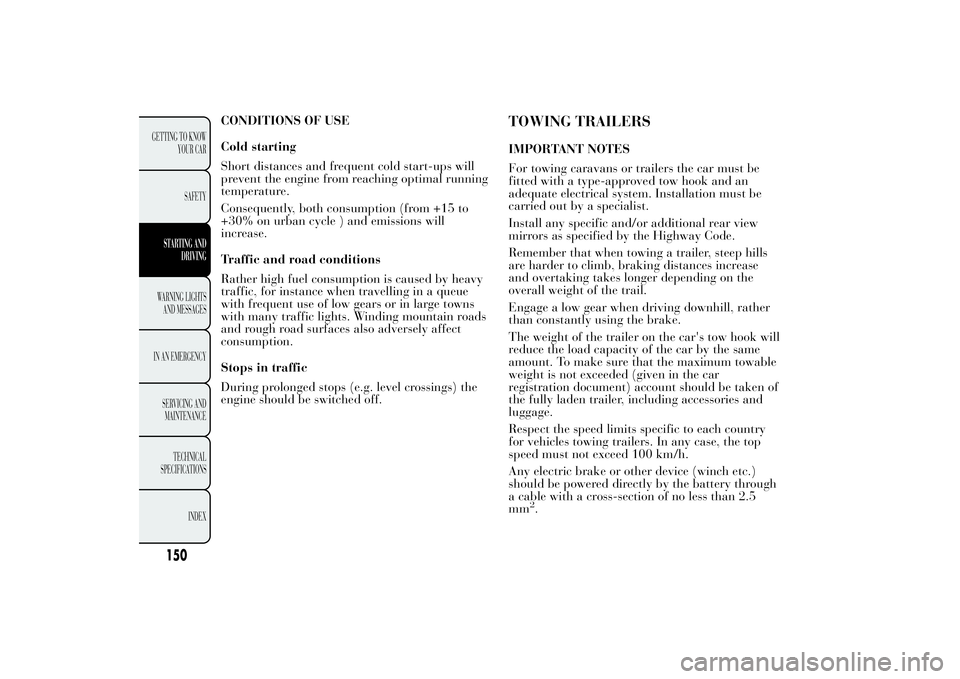engine Lancia Ypsilon 2012 Owner handbook (in English)
[x] Cancel search | Manufacturer: LANCIA, Model Year: 2012, Model line: Ypsilon, Model: Lancia Ypsilon 2012Pages: 307, PDF Size: 13.3 MB
Page 147 of 307

If, when the ignition key is at MAR the
warning light remains lit, turn the key to
STOP and then back to MAR; if the warning light
remains lit, try with the other keys provided
with the car.
Contact a Lancia Dealership if you still cannot
start the engine.
Warning light
will flash for 60
seconds after starting or during
prolonged cranking to indicate a fault
with the glow plug heating system. You can
use the car as usual if the engine starts but
you should contact a Lancia Dealership as
soon as possible.
WARNING
It is dangerous to run the engine in
enclosed areas. The engine takes
in oxygen and releases carbon dioxide,
carbon monoxide and other toxic gases.
WARNING
Remember that the brake servo and
power steering are not operational
until the engine has been started, therefore
much effort than usual is required on the
brake pedal and steering wheel.
We recommend that during the initial
period you do not demand to full
performance from the car (e.g.
excessive acceleration, long journeys at top
speed, sharp braking etc.).When the engine is switched off never
leave the key turned to MAR to prevent
useless current absorption from
draining the battery.Never jump start the engine by
pushing, towing or coasting downhill.
This could cause fuel to flow into the
catalytic converter and damage it beyond
repair.
HOW TO WARM UP THE ENGINE AFTER IT
HAS JUST STARTED
Proceed as follows:
❒Drive off slowly, letting the engine turn at
medium revs. Do not accelerate abruptly;
❒Do not demand full performance at first. Wait
until the engine coolant temperature gauge
starts moving.
145GETTING TO KNOW
YOUR CAR
SAFETYSTARTING AND
DRIVINGWARNING LIGHTS
AND MESSAGES
IN AN EMERGENCY
SERVICING AND
MAINTENANCE
TECHNICAL
SPECIFICATIONS
INDEX
Page 148 of 307

STOPPING THE ENGINE
Turn the ignition key to STOP while the engine is
idling.
IMPORTANT After a taxing drive, before turning
the engine off you should allow it to idle to allow
the temperature in the engine compartment to fall.
A quick burst on the accelerator before
turning off the engine serves absolutely
no practical purpose, it wastes fuel
and is damaging especially to turbocharged
engines.
PARKINGSwitch off the engine and engage the handbrake.
Engage a gear (first gear if parked uphill or
reverse if facing downhill) and leave the wheels
turned. If the car is parked on a steep slope block
the wheels with a wedge or stone. Always remove
the ignition key when leaving the car.
HANDBRAKE
To engage the handbrake pull lever A fig. 112
upwards until the car is secured. To release the
handbrake, raise the lever A slightly, press and
hold the button B and lower the lever.
If the car is parked on a steep slope, it is also
advisable to block the wheels with a wedge or
stone.
fig. 112
L0F0074
146
GETTING TO KNOW
YOUR CAR
SAFETY
STARTING AND
DRIVINGWARNING LIGHTS
AND MESSAGES
IN AN EMERGENCY
SERVICING AND
MAINTENANCE
TECHNICAL
SPECIFICATIONS
INDEX
Page 149 of 307

Never leave children in the unattended car. Always
remove the ignition key when leaving the car and
take it out with you.
WARNING
The car should be braked after a few
clicks of the lever, if it is not, contact
a Lancia Dealership to have it adjusted.
USING THE GEARBOXTo engage the gears, fully depress the clutch pedal
and put the gear lever into the required position
(the diagram is shown on the knob fig. 113).
For 0.9 TwinAir 85 HP and 1.2 8V 69 HP
versions, to engage reverse R from neutral, lift the
ring A fig. 113 and shift the lever to the right
and back.
For 1.3 16V MultiJet version: to engage reverse R
from neutral position, shift the lever to the right
and then back.
IMPORTANT Reverse can only be engaged when
the car is completely stationary. With the engine
running, wait for at least 2 seconds with the clutch
pedal fully pressed before engaging reverse to
prevent damage to the gears and grating.
fig. 113
L0F0058
147GETTING TO KNOW
YOUR CAR
SAFETYSTARTING AND
DRIVINGWARNING LIGHTS
AND MESSAGES
IN AN EMERGENCY
SERVICING AND
MAINTENANCE
TECHNICAL
SPECIFICATIONS
INDEX
Page 151 of 307

Electrical devices
Only use electrical devices for the amount of time
needed. The heated rear window, additional
headlights, windscreen wipers and heater fan need
a considerable amount of energy, therefore
increasing fuel consumption (by up to 25% in the
urban cycle).
Climate control system
The use of the climate control system leads to
higher fuel consumption. If the temperature
outside permits, try to use ventilation only.
Devices for aerodynamic control
The use of non-certified devices for aerodynamic
control may adversely affect air drag and fuel
consumption.
DRIVING STYLE
Starting
Do not warm the engine with the car at a
standstill or at idle or high speed: under these
conditions the engine warms up much more
slowly, increasing consumption and emissions. It is
therefore advisable to move off immediately,
slowly, avoiding high speeds: in this way
the engine will warm up more quickly.Unnecessary actions
Avoid revving up when at traffic lights or before
stopping the engine. This and also double
declutching is absolutely pointless on modern cars
and also increases consumption and pollution.
Gear selection
Use a higher gear as soon as traffic and road
conditions allow. Using a low gear for faster
acceleration will increase consumption.
In the same way improper use of a high gear
increases consumption, emissions and engine wear.
Maximum speed
Fuel consumption increases considerably with
speed. Maintain a constant speed, avoiding
unnecessary braking and acceleration, which cost
in terms of both fuel and emissions.
Acceleration
Sudden acceleration has a very negative effect on
fuel consumption and emissions: accelerate
gradually.
149GETTING TO KNOW
YOUR CAR
SAFETYSTARTING AND
DRIVINGWARNING LIGHTS
AND MESSAGES
IN AN EMERGENCY
SERVICING AND
MAINTENANCE
TECHNICAL
SPECIFICATIONS
INDEX
Page 152 of 307

CONDITIONS OF USE
Cold starting
Short distances and frequent cold start-ups will
prevent the engine from reaching optimal running
temperature.
Consequently, both consumption (from +15 to
+30% on urban cycle ) and emissions will
increase.
Traffic and road conditions
Rather high fuel consumption is caused by heavy
traffic, for instance when travelling in a queue
with frequent use of low gears or in large towns
with many traffic lights. Winding mountain roads
and rough road surfaces also adversely affect
consumption.
Stops in traffic
During prolonged stops (e.g. level crossings) the
engine should be switched off.
TOWING TRAILERSIMPORTANT NOTES
For towing caravans or trailers the car must be
fitted with a type-approved tow hook and an
adequate electrical system. Installation must be
carried out by a specialist.
Install any specific and/or additional rear view
mirrors as specified by the Highway Code.
Remember that when towing a trailer, steep hills
are harder to climb, braking distances increase
and overtaking takes longer depending on the
overall weight of the trail.
Engage a low gear when driving downhill, rather
than constantly using the brake.
The weight of the trailer on the car's tow hook will
reduce the load capacity of the car by the same
amount. To make sure that the maximum towable
weight is not exceeded (given in the car
registration document) account should be taken of
the fully laden trailer, including accessories and
luggage.
Respect the speed limits specific to each country
for vehicles towing trailers. In any case, the top
speed must not exceed 100 km/h.
Any electric brake or other device (winch etc.)
should be powered directly by the battery through
a cable with a cross-section of no less than 2.5
mm
2.
150
GETTING TO KNOW
YOUR CAR
SAFETY
STARTING AND
DRIVINGWARNING LIGHTS
AND MESSAGES
IN AN EMERGENCY
SERVICING AND
MAINTENANCE
TECHNICAL
SPECIFICATIONS
INDEX
Page 153 of 307

In addition to the electrical branches, the car's
electrical system can be connected only to the
supply cable for an electric brake and to the cable
for an internal trailer light, though not more
than 15 W. To connect, use the preset control unit
with a battery cable with cross-section no less
than 2.5 mm
2.
IMPORTANT The use of auxiliary loads other
than external lights (electric brake, winch, etc.)
must occur with engine running.
IMPORTANT To install a tow hook contact a
Lancia Dealership.
WARNING
The ABS with which the car may be
equipped will not control the braking
system of the trailer. Particular caution is
required on slippery roads.
WARNING
Never modify the braking system of
the car to control the trailer brake.
The trailer braking system must be fully
independent of the car’s hydraulic system.
SNOW TYRESUse snow tyres of the same size as the normal
tyres provided with the car.
A Lancia Dealership will be happy to provide
advice concerning the most suitable type of tyre
for the customer's requirements.
For the type of tyre to be used, inflation pressures
and the specifications of snow tyres, follow the
instructions given in paragraph "Wheels" in
section "Technical specifications".
The winter performance of these tyres is
considerably reduced when the tread thickness is
less than 4 mm. Replace them in this case.
Due to their specific features, the performance of
snow tyres is much lower than that of normal
types in normal conditions or long motorway
stretches. Their usage should therefore be
restricted in accordance with their type approval.
IMPORTANT When using snow tyres with a
maximum speed index below the one that can be
reached by the car (increased by 5%), place a
notice in the passenger compartment, plainly in
view, which states the maximum speed allowed by
the snow tyres (as per EC Directive).
All four tyres should be the same (brand and
track) to ensure greater safety when driving and
braking and better driveability. Remember that
you should not change the rotation direction of the
tyres.
151GETTING TO KNOW
YOUR CAR
SAFETYSTARTING AND
DRIVINGWARNING LIGHTS
AND MESSAGES
IN AN EMERGENCY
SERVICING AND
MAINTENANCE
TECHNICAL
SPECIFICATIONS
INDEX
Page 155 of 307

STORING THE CARIf the car is to be left inactive for longer than a
month, the following precautions should be
observed:
❒park the car in covered, dry and if possible
well-ventilated premises and slightly open
the windows;
❒engage a gear and check that the handbrake is
not engaged;
❒disconnect the negative battery terminal (for
versions with Start&Stop system refer to the
paragraph "Start&Stop system" in the chapter
"Knowing your car"); If the battery is not
disconnected the from the electrical system,
check its charge every thirty days;❒clean and protect the painted parts using
protective wax;
❒clean and protect the shiny metal parts using
special compounds available commercially;
❒sprinkle talcum powder on the rubber
windscreen and rear window wiper blades and
lift them off the glass;
❒cover the car with a cloth or perforated plastic
sheet. Do not use sheets of non-perforated
plastic as they do not allow moisture on the car
body to evaporate;
❒inflate tyres to +0.5 bar above the standard
specified pressure and check it at intervals;
❒do not drain the engine cooling system.
153GETTING TO KNOW
YOUR CAR
SAFETYSTARTING AND
DRIVINGWARNING LIGHTS
AND MESSAGES
IN AN EMERGENCY
SERVICING AND
MAINTENANCE
TECHNICAL
SPECIFICATIONS
INDEX
Page 157 of 307

The warning light (or symbol on the display)
switches on when the handbrake is engaged. If the
car is moving the buzzer will also sound.
IMPORTANT If the warning light comes on when
the car is in motion, check that the handbrake
is not on.
EBD FAILURE (red)
(amber)
The simultaneous switching on of the
(red),
(amber) andESCwarning lights with the
engine on, indicates either a failure of the EBD
system or that the system is not available. In this
case, the rear wheels may suddenly lock and
the vehicle may swerve when braking sharply.
Drive very carefully to the nearest Lancia
Dealership to have the system inspected
immediately. On some versions the display shows
the dedicated message.
ABS SYSTEM FAILURE (amber)
Turning the key to the MAR position switches on
the warning light, but it should switch off after
a few seconds. The warning light switches on (on
some versions, with a message on the display
and a symbol on the display) when the system is
not efficient. In this case the braking system
maintains its own efficiency unaltered but without
the advantage of the ABS system.
Drive carefully and contact a Lancia Dealership as
soon as possible.AIRBAG FAILURE (red)
Turning the key to the MAR-ON position
illuminates the warning light, but it should switch
off after a few seconds.
The warning light switches on constantly (on some
versions, with a message on the display and a
symbol on the display) to indicate an airbag
system fault.
155GETTING TO KNOW
YOUR CAR
SAFETY
STARTING AND
DRIVINGWARNING LIGHTS
AND MESSAGESIN AN EMERGENCY
SERVICING AND
MAINTENANCE
TECHNICAL
SPECIFICATIONS
INDEX
HANDBRAKE ENGAGED
When the key is turned to MAR position, the
warning light switches on but should switch off
after a few seconds.
Page 159 of 307

UNFASTENED SEAT BELTS (red)
(for versions/markets, where provided)
The warning light switches on constantly with the
car stationary and the driver's side or passenger
side seat belt (when the passenger is present)
not fastened.
The warning light will flash and a buzzer will
sound if the vehicle is in motion and the front seat
belts are not correctly fastened.
Contact a Lancia Dealership if you wish to
permanently deactivate the S.B.R. (Seat Belt
Reminder) system buzzer. The system can be
reactivated using the Setup menu (see the
description in the chapter "Knowing your car").LOW BATTERY CHARGE (red)
(for versions/markets, where provided)
When the ignition key is moved to MAR, the
warning light switches on but should switch off as
soon as the engine is started (with the engine
idling, a brief delay can be expected).
If the warning light (or, on some versions, a
message and a symbol on the display) remains on
constantly or flashing, contact a Lancia
Dealership.
CONTINUOUSLY ON: LOW ENGINE
OIL PRESSURE (red)
ON FLASHING: ENGINE OIL
DETERIORATED
(only Diesel versions with DPF - red)
When the ignition key is moved to MAR, the
warning light switches on but should switch off as
soon as the engine is started.
1. Insufficient engine oil pressure
The warning light switches on constantly together
(for versions/markets, where provided) with a
message on the display when the system detects
that the engine oil pressure is too low.
WARNING
If the
warning light switches on
when the vehicle is travelling (on
certain versions together with the message
on the display) stop the engine immediately
and contact a Lancia Dealership.
157GETTING TO KNOW
YOUR CAR
SAFETY
STARTING AND
DRIVINGWARNING LIGHTS
AND MESSAGESIN AN EMERGENCY
SERVICING AND
MAINTENANCE
TECHNICAL
SPECIFICATIONS
INDEX
Page 160 of 307

2. Engine oil deteriorated
(only Diesel versions with DPF)
The warning light will flash and a specific
message will appear on the display (in versions/
markets, where provided). The warning light may
flash in the following ways, depending on the
version:
❒1 minute every two hours;
❒cycles of 3 minutes with intervals with the
warning light off for 5 seconds until the oil
is changed.
After the first indication, at each engine start up
the warning light will continue flashing as
described above until the oil is changed. For
(versions/markets where provided), the display
shows a dedicated message together with the
warning light.
The flashing of the warning light should not be
considered as a fault, it simply informs the
customer that the oil needs to be changed
following normal car use.Remember that the deterioration of the engine oil
is accelerated by:
❒mainly town use of the car which makes the
DPF regeneration process more frequent;
❒use of the car for short drives, in which the
engine does not have time to reach its regular
operating temperature;
❒repeated interruption of the regeneration
process, signalled by the DPF warning light
coming on.
WARNING
If the warning light comes on, the
exhausted engine oil should be
changed as soon as possible; never drive
more than 500 km from the first
switching-on of this warning light. Failure to
observe the above may result in severe
damage to the engine and invalidate the
warranty. Remember that when the warning
light comes on, it does not mean that the
level of engine oil is low, so if the light
flashes you do not need to top up the engine
oil.
158
GETTING TO KNOW
YOUR CAR
SAFETY
STARTING AND
DRIVINGWARNING LIGHTS
AND MESSAGESIN AN EMERGENCY
SERVICING AND
MAINTENANCE
TECHNICAL
SPECIFICATIONS
INDEX